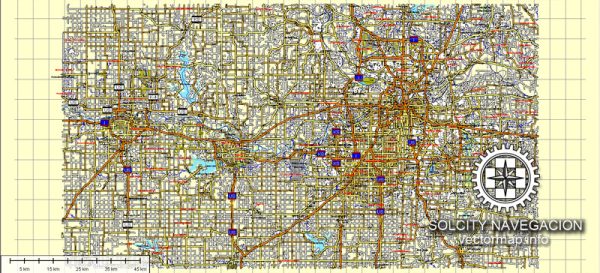The urban development of Kansas City, Lawrence, and Topeka in the United States is a fascinating story that reflects the broader trends and challenges faced by many American cities. Each of these cities has a unique history, but there are some common themes in their urban development.
Kansas City:
Early Settlement and Expansion:
- Kansas City, Missouri, was founded in the 1830s as a port on the Missouri River. Its location made it a natural hub for trade and transportation.
- The city’s growth was further spurred by the westward expansion, the Oregon Trail, and the California Gold Rush in the mid-19th century.
Economic Growth and Railroads:
- The late 19th and early 20th centuries saw the city’s economy booming, partly due to its strategic location as a railroad hub.
- The stockyards and meatpacking industry played a significant role in the city’s economic development, earning it the nickname “Cowtown.”
Jazz and Culture:
- In the early 20th century, Kansas City became renowned for its jazz scene, with vibrant nightlife in places like the 18th and Vine District.
- The city’s cultural contributions have continued, and it remains a center for arts and music.
Suburbanization and Urban Renewal:
- Like many American cities, Kansas City experienced suburbanization in the mid-20th century, with people moving to the outskirts.
- Urban renewal projects, such as the Crown Center and the Power and Light District, aimed to revitalize the downtown area.
Lawrence:
Founding and Free State History:
- Lawrence, Kansas, was founded in the 1850s as an anti-slavery stronghold during the tumultuous years leading up to the Civil War.
- It played a key role in the “Bleeding Kansas” conflict and was a center for the abolitionist movement.
Education and Culture:
- The city is home to the University of Kansas, which has been a significant influence on Lawrence’s cultural and intellectual life.
- The historic downtown area is known for its unique shops, restaurants, and cultural events.
Growth and Challenges:
- Lawrence has faced challenges related to growth and development, balancing the preservation of its historic character with the need for economic progress.
Topeka:
Early Settlement and State Capital:
- Topeka, the capital of Kansas, was founded in the 1850s along the Kansas River.
- It became the state capital in 1861, and its development was influenced by its role as a political and administrative center.
Brown v. Board of Education:
- Topeka gained national prominence with the landmark Supreme Court case Brown v. Board of Education in 1954, which declared segregation in public schools unconstitutional.
- The Brown v. Board National Historic Site preserves the former Monroe Elementary School and commemorates the struggle for civil rights.
Economic Diversification:
- Topeka’s economy has diversified over the years, with government, healthcare, education, and manufacturing playing significant roles.
Common Urban Challenges and Trends:
Suburbanization:
- Like many American cities, all three faced suburbanization in the mid-20th century, leading to challenges related to urban sprawl and infrastructure development.
Urban Renewal:
- Urban renewal projects aimed at revitalizing downtown areas were common in the mid-20th century, sometimes resulting in the demolition of historic structures.
Contemporary Issues:
- Today, these cities grapple with issues such as infrastructure maintenance, affordable housing, and sustainable development.
The histories of Kansas City, Lawrence, and Topeka illustrate the complex and evolving nature of urban development in the United States, shaped by historical events, economic forces, and the efforts of the communities that call these cities home.


 Author: Kirill Shrayber, Ph.D.
Author: Kirill Shrayber, Ph.D.